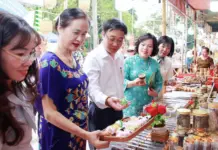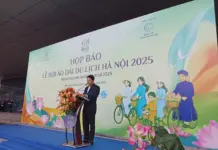|
In 1945, 48 Hang Ngang Street was the address of the Phuc Loi silk shop, but also served as a clandestine revolutionary base. More than seven decades since, the house retains its original architecture.
On the first floor, photos and objects used by President Ho Chi Minh and other revolutionaries are exhibited. These include the khaki costume that President Ho Chi Minh wore when reading the Declaration of Independence on September 2, 1945, and the rattan-made suitcase he used when staying at 48 Hang Ngang Street.
On the second floor is the workroom of President Ho Chi Minh and the Communist Party Central Committee, with its furniture preserved. In the middle of the room stands a rectangular table with four chairs on each side and a larger chair at one end. This was the place where President Ho Chi Minh and the Communist Party Central Committee adopted the Declaration of Independence, decided to organize a ceremony to announce Vietnam’s National Day and finalized the list of members of the provisional government. Another room on the second floor is where President Ho Chi Minh wrote the Declaration of Independence.
Trinh Can Chinh, a son of Hoang Thi Minh Ho and Trinh Van Bo who owned the Phuc Loi silk shop, explained why the Communist Party Central Committee chose the house to accommodate President Ho Chi Minh when he returned to Hanoi to prepare for the ceremony giving birth to the Democratic Republic of Vietnam. He said the house with two entrances (48 Hang Ngang and 35 Hang Can) enabled quick withdrawal if needed. Moreover, the silk shop on the first floor served as camouflage for the revolutionary base, he added.
According to Quach Thi Huong Tra, a tour guide from the Hanoi Relics Management Board, Trinh Van Bo and his wife, Hoang Thi Minh Ho, gave all the rooms on the second floor to President Ho and members of the Central Committee for use. From August 25 to September 2, 1945, President Ho Chi Minh and the Central Committee made important decisions related to internal and external relations, as well as the provisional government.
During the initial days of the 1945 August Revolution, Trinh Van Bo and his wife, Hoang Thi Minh Ho, donated 5,147 taels of gold to the revolution. They also mobilized other businesspeople in Hanoi to donate more than 1,000 taels of gold to the cause. President Ho dubbed his generous hosts “benefactors of the revolution”.
In 1970, the house at 48 Hang Ngang Street was restored to serve as a memorial. In 1979, it was recognized by the Ministry of Culture and Information, now the Ministry of Culture, Sports and Tourism, as a national relic.
Thanh Tam & Bui Hung




